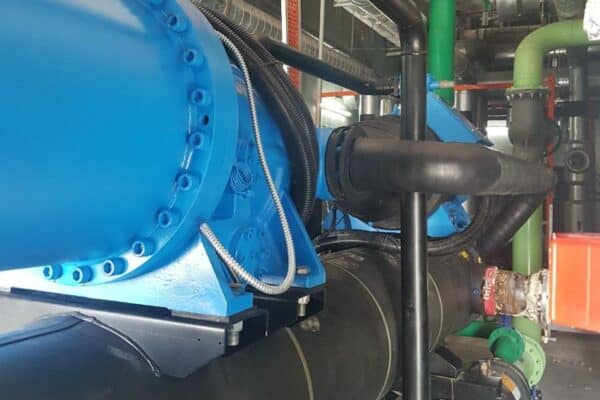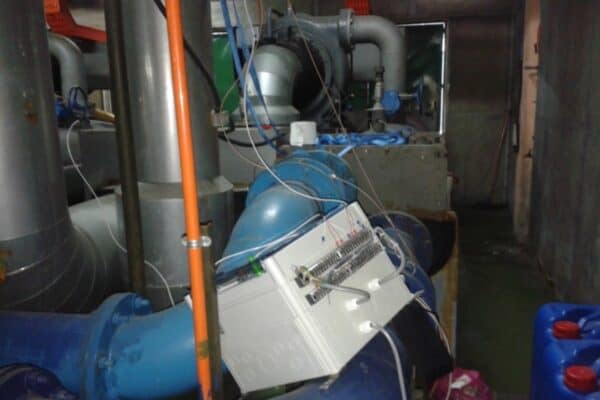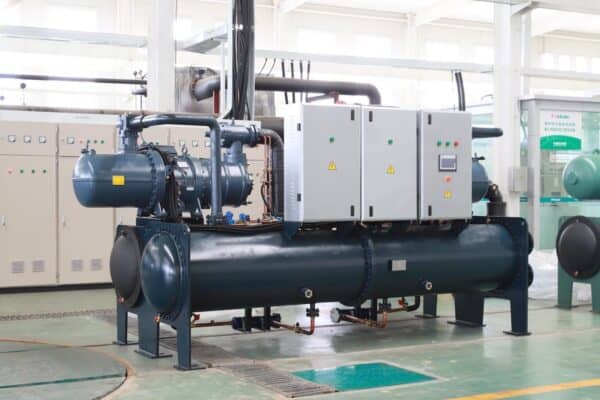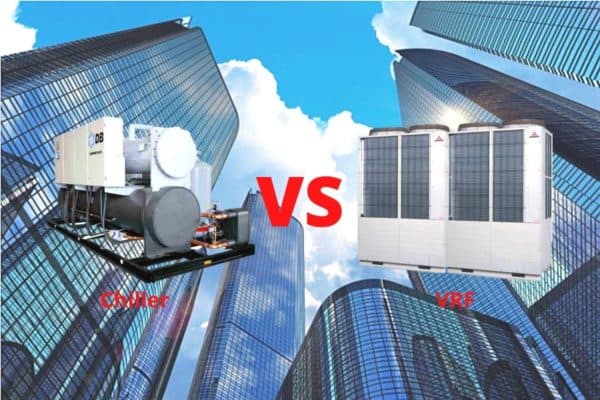Chiller Efficiency Calculation: kW/Ton, COP, EER & IPLV/NPLV
Chiller efficiency is one of the most discussed topics among HVAC engineers. However, chiller efficiency is represented in many different units of measurement and certain units may not be stated on the brochures. So, how do you calculate chiller efficiency?
kW/Ton is the most common unit of measurement for chiller efficiency.
To calculate chiller kW/Ton, divide the power input of the chiller in kW by the cooling capacity of the chiller in refrigeration tonnage or RT. Alternatively, divide 3.5 by the COP of the chiller to get the chiller efficiency in kW/Ton.
| Cooling Capacity | Power Input | Efficiency |
|---|---|---|
| 100 Ton | 60 kW | 60 kW ÷ 100 Ton = 0.60 kW/Ton |
| 100 Ton x 12000 = 1,200,000 btu/hr | 60 kW x 1000 = 60,000 W | 1,200,000 btu/hr ÷ 60,000 W = 20 EER |
| 1,200,000 btu/hr ÷ 3412 = 352 kW | 60,000 W ÷ 1000 = 60 kW | 352 kW ÷ 60 kW = 5.86 COP |
| Conversion | Formula |
|---|---|
| EER to kW/Ton | 12 ÷ EER = kW/Ton |
| EER to COP | EER ÷ 3.412 = COP |
| COP to kW/Ton | 3.5 ÷ COP = kW/Ton |
Chiller efficiency calculations are mostly easy. However, certain units like IPLV for part-load efficiency is a bit tricky. So, let’s take a closer look at the chiller efficiency calculation.
Watch my YouTube video on the different measurement units used for efficiency:
How to Calculate Chiller Efficiency?
There are 4 common units of measurement for chiller efficiency; kW/Ton, COP, EER and IPLV/NPLV. In the following, I’ll explain the calculation process of each unit with an example.
a) Chiller kW/Ton Calculation
kW/Ton stands for kilowatt per refrigerant tonnage. So, to calculate chiller kW/Ton, divide the power input of the chiller in kW by the cooling capacity of the chiller in RT.
Below is an example of the chiller kW/Ton calculation:
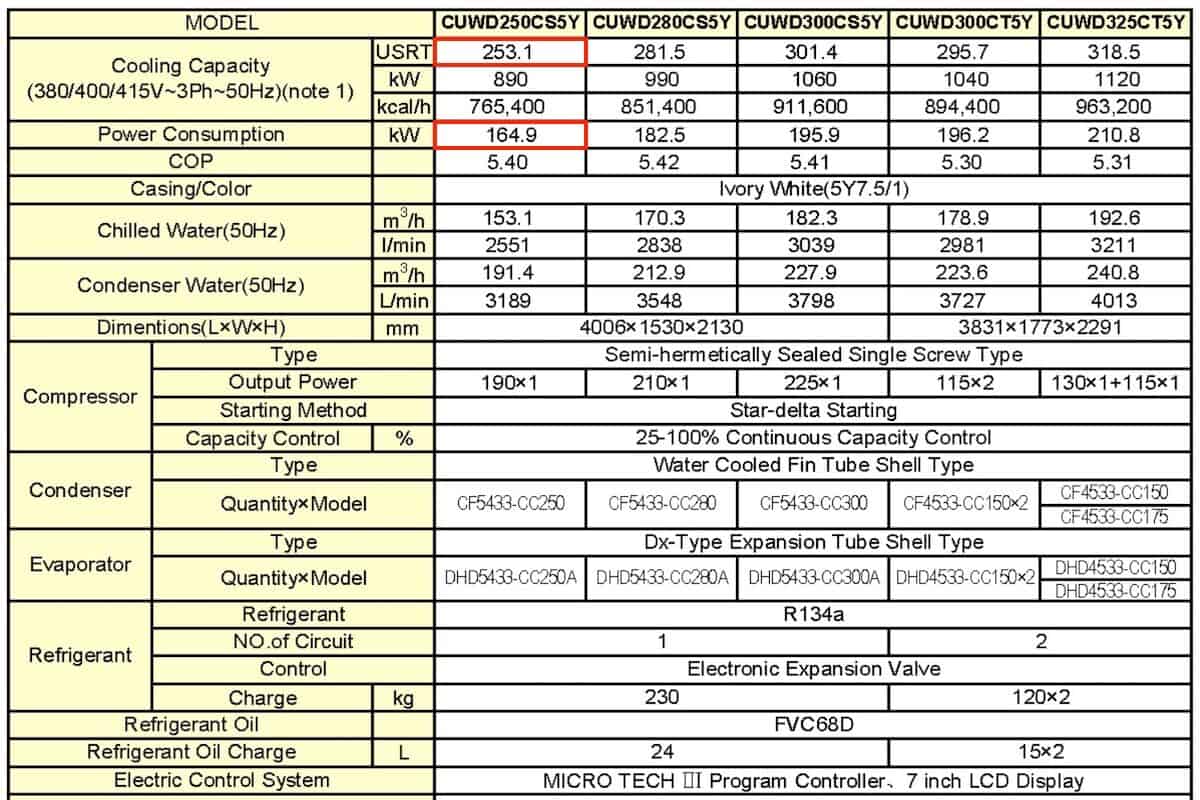
From the above datasheet, the chiller (model no.: CUWD250CS5Y) has a cooling capacity of 253.1 RT at a power consumption of 164.9 kW. So, the kW/Ton of the chiller can be calculated as follow:
Chiller Efficiency = Power Consumption (kW) ÷ Chiller Capacity (RT)
Chiller Efficiency = 164.9 ÷ 253.1
Chiller Efficiency = 0.65 kW/Ton
Since a chiller is more efficient when it consumes less power and delivers more capacity, the lower the chiller kW/Ton, the higher the chiller efficiency.
Sometimes, the cooling capacity of chillers is expressed in terms of kW (kilowatt) or btu/hr (British Thermal Unit per hour). If that’s the case, convert the cooling capacity into RT before calculating the kW/Ton.
For cooling capacity conversion:
- 1 RT = 12,000 btu/hr
- 1 kW = 3,412 btu/hr
To learn more about the different units of measurement for cooling capacity, see my post BTU to HP | BTU to Ton | BTU to kW | Conversion Tables.
Now, take the above chiller (model no.: CUWD250CS5Y) as an example. The cooling capacity is 890 kW. So, the calculation for the kW/Ton can be as follow:
Chiller Efficiency = Power Consumption (kW) ÷ Chiller Capacity (RT)
Chiller Efficiency = 164.9 ÷ (890 x 3412 ÷ 12000)
Chiller Efficiency = 0.65 kW/Ton
Using the same principle, you can always calculate the kW/Ton of a chiller even though the chiller’s cooling capacity is stated in units other than RT.
On a side note, if you want to quickly learn about chilled water system, you can get my Chilled Water System (eBook). If you’re into design, you can enroll in my Chilled Water System Design Course where I teach you various design procedures with tons of examples.
Chilled Water System Design Course
Learn how to design a chilled water system with AHU/FCU selection, chiller sizing, cooling tower sizing, pump sizing, piping design, ductwork design and more.
b) Chiller COP Calculation
COP stands for coefficient of performance and it is expressed in terms of kW/kW (kilowatt per kilowatt). In other words, chiller COP is calculated by dividing the cooling capacity of the chiller in kW by the power input of the chiller in kW as well.
As a result, chiller COP is unitless.
Let’s take a look at an example of chiller COP calculation as follow:

Take the same chiller (model no.: CUWD250CS5Y) as an example. The cooling capacity of the chiller is 890 kW and the power consumption of the chiller is 164.9 kW.
So, the COP of the chiller can be calculated as follow:
Coefficient of Performance, COP = Cooling Output (kW) ÷ Power Input (kW)
Coefficient of Performance, COP = 890 ÷ 164.9
Coefficient of Performance, COP = 5.40
The COP of 5.40 is also stated on the above chiller datasheet. However, not all manufacturers publish the COP of their chillers on their brochures.
So, if you like to use COP for comparison, you may need to calculate yourself. Since COP is a measure of output over input, the higher the chiller COP, the higher the chiller efficiency.
In addition, you can divide 3.5 by the COP of the chiller to get the chiller efficiency in kW/Ton. For instance, 3.5 divided by 5.4 is 0.65 kW/Ton.
c) Chiller EER Calculation
EER (energy efficiency ratio) is a general way to represent the energy efficiency of air conditioners including chillers. Usually, EER is calculated by dividing the cooling capacity in btu/hr by the power input in Watt.
However, that’s not always the case for chillers. Let’s take a look at the following example:
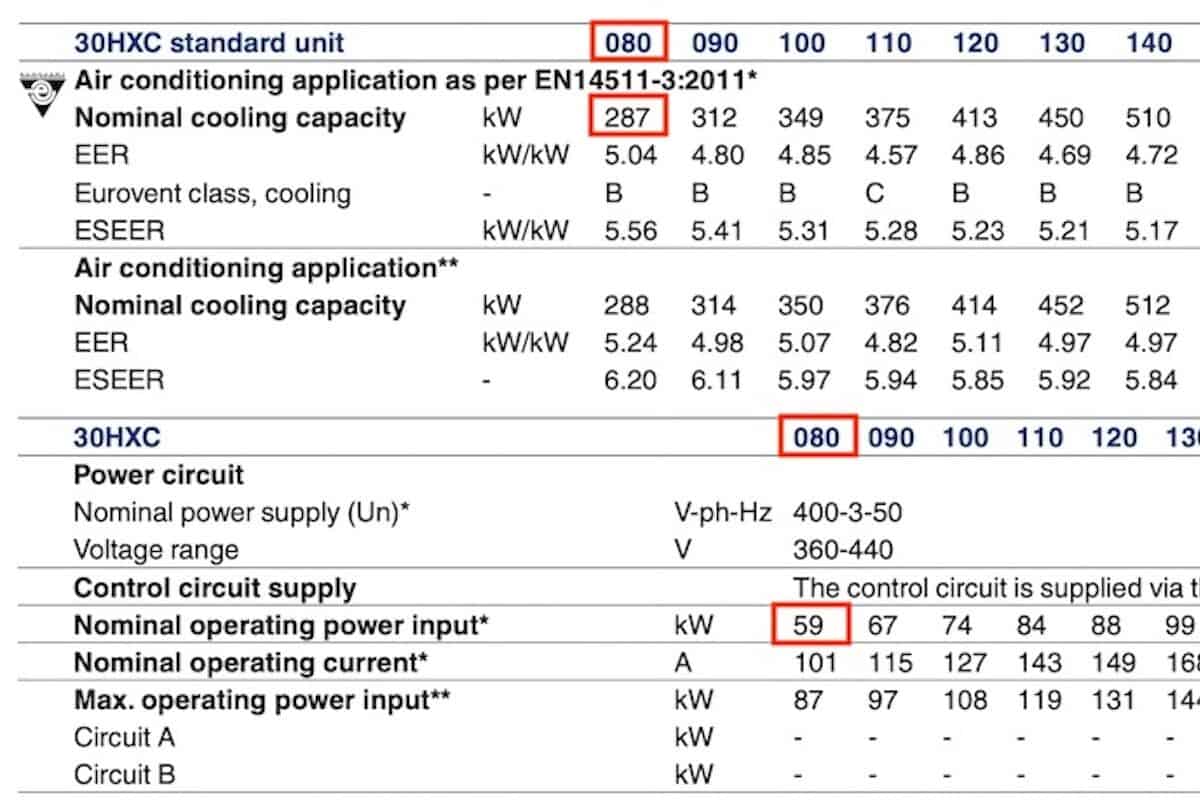
From the above datasheet, the EER of the chiller (model 080) is apparently calculated the same as COP which is dividing the cooling capacity in kW by the power input in W.
However, if you want to use EER as a comparison metric, it can be calculated as follow:
Energy Efficiency Ratio, EER = Cooling Capacity (btu/hr) ÷ Power Input (W)
Energy Efficiency Ratio, EER = (287 x 3412) ÷ (59 x 1000)
Energy Efficiency Ratio, EER = 16.60
In context, the average EER of portable air conditioners, window air conditioners and ductless mini splits are 7, 12 and 15 respectively. Hence, the chiller with an EER of 16.6 (the higher the better) is more efficient than most room air conditioners.
To convert EER to COP, divide EER by 3.412. For example, 16.6 EER divided by 3.412 equals 4.86 COP.
COP = EER ÷ 3.412
The number, 3.412 comes from the division 3412 ÷ 1000 which is the conversion from cooling capacity kW to BTU and electrical power kW to W.
For chillers, many people often use EER and COP interchangeably. However, I like to be precise with the unit of EER and COP being btu/hr/W and kW/kW respectively.
As for the conversion from EER to kW/Ton, divide 12 by EER. For example, the cooling capacity is 287 kW and thus, in terms of Ton, it is 81.6 Ton. Given that the power is 59 kW, the efficiency is equivalent to 59 ÷ 81.6 = 0.72 kW/Ton. Alternatively, 12 divided by 16.6 is also 0.72 kW/Ton.
kW/Ton = 12 ÷ EER
The number, 12 comes from the division 12000 ÷ 1000 which the 12000 is the conversion from btu/hr to ton and the 1000 is the conversion from kW to W.
For more context, the EER and COP used in chillers are calculated the same as those used in residential air conditioners such as mini split and heat pump. See my post about different energy efficiency codes.
d) Chiller IPLV/NPLV Calculation
IPLV or integrated part load value is perhaps the most important metric to compare for the energy efficiency of chillers.
kW/Ton, COP and EER represent the energy efficiency of a chiller at full-load conditions (100% load). However, in reality, chillers rarely run at 100% load but part-load (eg: 30%, 50% or 70%) most of the time.
Hence, IPLV is a more accurate representation of the actual efficiency of a chiller.
Sometimes, you may find the NPLV of a chiller on top of the IPLV. NPLV stands for non-standard part load value. The chiller NPLV calculation is exactly the same as the chiller IPLV calculation.
For IPLV, the water temperature conditions are set as follow:
- Chilled Water Supply Temperature = 6.7°C (44°F)
- Condenser Water Supply Temperature = 29.4°C (85°F)
To learn what water temperature is typically used for chiller, check out my post about high delta T chilled water system where I compare standard chilled water temperature against high delta T setup.
Chiller IPLV/NPLV calculation is a bit complicated. So, I’ll use the following example to explain:
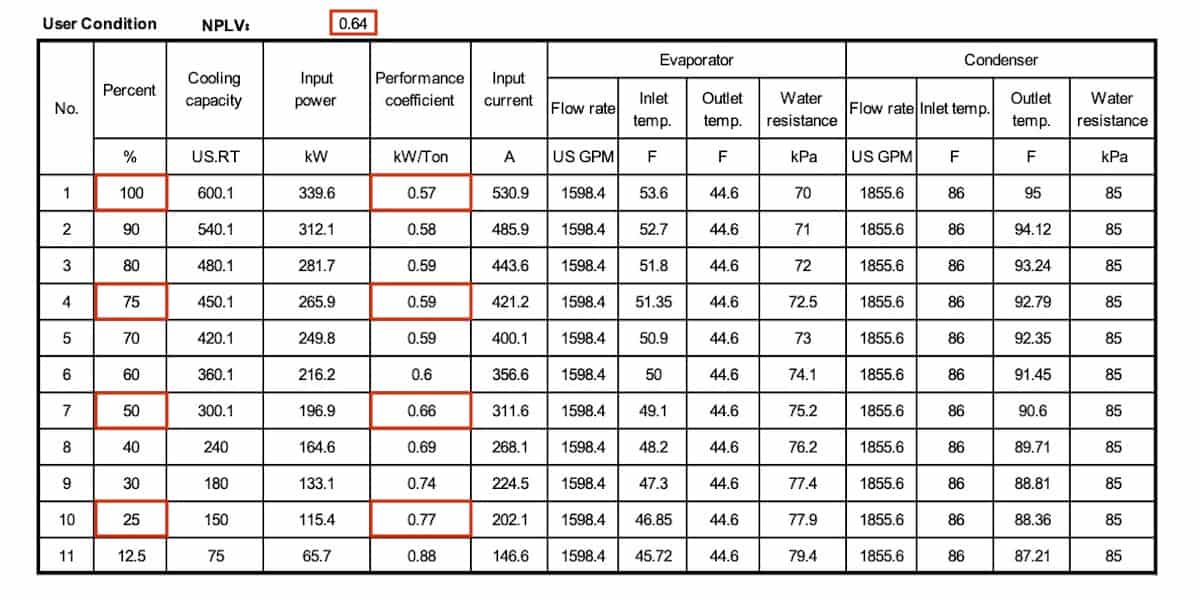
The above datasheet is the part-load performance of a 600 RT chiller I designed previously.
Notice that it shows NPLV instead of IPLV because the evaporator outlet temperature (chilled water supply temperature) is 7°C (44.6°F) instead of 6.7°C (44°F) and the condenser inlet temperature (condenser water supply temperature) is 30°C (86°F) instead of 29.4°C (85°F).
From there, IPLV/NPLV as per the AHRI 550/590 standard is calculated based on the weighted part-load efficiency as follow:
| Chiller Load | Operating Time |
|---|---|
| 100% | 1% |
| 75% | 42% |
| 50% | 45% |
| 25% | 12% |
Now, the formula to calculate IPLV/NPLV is as follow:
IPLV/NPLV = (Chiller Efficiency at 100% Load x 1%) + (Chiller Efficiency at 75% Load x 42%) + (Chiller Efficiency at 50% Load x 45%) + (Chiller Efficiency at 25% Load x 12%)
So, let’s extract the chiller efficiency values from the datasheet shown earlier:
| Chiller Load | Chiller Efficiency |
|---|---|
| 100% | 0.57 kW/Ton |
| 75% | 0.59 kW/Ton |
| 50% | 0.66 kW/Ton |
| 25% | 0.77 kW/Ton |
Therefore, the IPLV/NPLV of the chiller can be calculated as follow:
IPLV/NPLV = (Chiller Efficiency at 100% Load x 1%) + (Chiller Efficiency at 75% Load x 42%) + (Chiller Efficiency at 50% Load x 45%) + (Chiller Efficiency at 25% Load x 12%)
IPLV/NPLV = (0.57 x 1%) + (0.59 x 42%) + (0.66 x 45%) + (0.77 x 12%)
IPLV/NPLV = 0.64 kW/Ton
IPLV/NPLV can be expressed in units other than kW/Ton including COP and EER based on the unit used in the calculation. So, if you’re IPLV in not expressed in terms of kW/Ton, find the kW/Ton of your chillers in in the above load % and use the IPLV formula to convert your IPLV to kW/Ton.
The efficiency of a chiller is depending on many factors. One of them is the type of the chiller. So, I encourage you read my post about the 5 types of chillers and their efficiency if you want to learn more about chiller efficiency.
Calculating Chiller Efficiency Without Chiller Capacity
For existing chillers, the cooling capacity may not be the same as what is stated on the brochure because aged chillers have a drop in performance including their cooling capacity.
So, to calculate chiller efficiency, we need to first calculate the chiller capacity using the familiar formula as follow:
Q = ρmcθ
where,
Q = chiller capacity, kW
ρ = water density, 997 kg/m3
m = chilled water flow rate, m3/s
c = specific heat capacity of water, 4.2 kJ/kg°C
θ = chilled water temperature difference, °C
To calculate chiller capacity, you need to log the following data:
- Chilled water supply temperature
- Chilled water return temperature
- Chilled water flow rate
As an example, I’ll use one of my previous projects which involved the energy audit of a chiller plant for the calculation. Below is a portion of the logged data:
| Time | CHWS Temp. | CHWR Temp. | Water Flow | Chiller Capacity |
|---|---|---|---|---|
| 1pm | 8.41°C | 11.95°C | 177 m3/hr | 207 RT |
| 2pm | 8.84°C | 12.38°C | 191 m3/hr | 224 RT |
| 3pm | 8.87°C | 12.47°C | 180 m3/hr | 214 RT |
| 4pm | 9.37°C | 12.95°C | 170 m3/hr | 201 RT |
| 5pm | 9.93°C | 13.31°C | 175 m3/hr | 196 RT |
Based on the above data, the chiller capacity at 1pm can be calculated as follow:
Q = ρmcθ
Q = 997 x (177 ÷ 3600) x 4.2 x (11.95 – 8.41)
Q = 729 kW
Now, let’s convert the chiller capacity from kW to RT as follow:
Chiller Capacity = 729 x 3412 ÷ 12000
Chiller Capacity = 207 RT
The original cooling capacity of the chiller is 400 RT. At 75% load, the chiller is supposed to have a cooling capacity of 300 RT. However, the chiller has only 207 RT which is about 30% less.
Now, assuming that the part-load efficiency is 0.59 kW/Ton at 75% load, the power consumption of a typical 400 RT water-cooled screw chiller at 75% load is about 177 kW.
Given that the power consumption remains unchanged after 8 years in operation, the current chiller efficiency can be estimated as follow:
Chiller Efficiency = Power Consumption (kW) ÷ Chiller Capacity (RT)
Chiller Efficiency = 177 ÷ 207
Chiller Efficiency = 0.86 kW/Ton
When comparing 0.86 kW/Ton to 0.59 kW/Ton, the chiller efficiency has a drop of more than 45% after 8 years in operation. That’s a huge cost-saving potential there!
If you’re not able to measure the water flow rate, then you can calculate the chilled water or the condenser water flow rate. For that, see my post Chilled Water Flow Rate Calculation and Condenser Water Flow Rate Calculation.
Summary
Chiller efficiency calculation isn’t as hard as many people think. Now, let’s summarize all of the different chiller efficiency calculations in the following:
- Chiller kW/Ton Calculation – Divide the power input of the chiller in kW by the cooling capacity of the chiller in RT. The lower the chiller kW/Ton, the higher the chiller efficiency
- Chiller COP Calculation – Divide the cooling capacity of the chiller in kW by the power input of the chiller in kW. The higher the chiller COP, the higher the chiller efficiency.
- Chiller EER Calculation – Divide the cooling capacity in btu/hr by the power input in Watt. The higher the chiller EER, the higher the chiller efficiency.
- Chiller IPLV/NPLV Calculation – Sum up the products of chiller efficiency at 4 different part-load conditions weighted based on the AHRI standard.
Once again, you can get my Chilled Water System (eBook) to quickly learn more about chilled water system. But, if you want to learn how to design a chilled water system from start to end, I encourage you check out my Chilled Water System Design Course.
Chilled Water System Design Course
Learn how to design a chilled water system with AHU/FCU selection, chiller sizing, cooling tower sizing, pump sizing, piping design, ductwork design and more.
If you have anything to add (or ask) about this topic, leave a comment down below!




